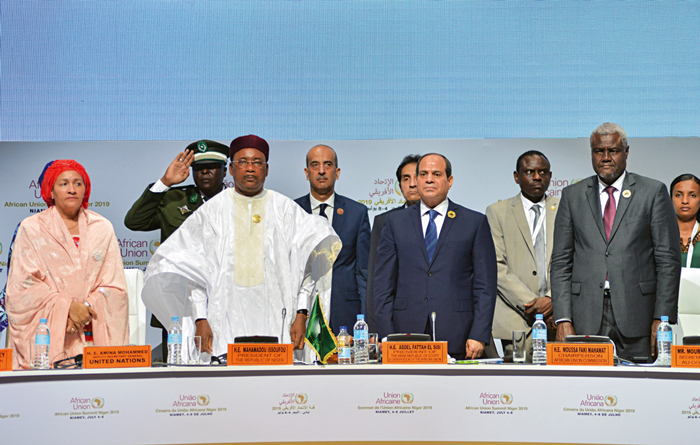|
||||||||||
| Home Nation World Business Opinion Lifestyle ChinAfrica Multimedia Columnists Documents Special Reports |
|
||||||||||
| Home Nation World Business Opinion Lifestyle ChinAfrica Multimedia Columnists Documents Special Reports |
| ChinAfrica |
| Toward a Stronger Union |
| China’s partnership with the AU is crucial to the realization of the Agenda 2063 |
| By Charles Onunaiju 丨VOL. 14 JULY 2022 ·2022-07-06 |

AfCFTA is officially launched during the AU Extraordinary Summit in Niamey, Niger, on July 7, 2019 (XINHUA)
The transition from the Organization of African Unity (OAU) to the African Union (AU) in 2002 was a historic starting point for the African continent. The OAU was the crystallization of the Pan-African sentiments that swept through the continent against the backdrop of the popular anti-colonial struggle, and was its foremost institutional expression. Born amidst fanfare, the OAU was also a compromise between different ideologies and political temperaments - a significant and huge achievement in finding a common ground. Despite all this, the organization was affected and even constrained by the then paralyzing Cold War international system.
Its boldest move to identify the structural challenges and other weakness of functional integration was the document of the Lagos Plan of Action of its special summit, held in the then capital of Nigeria in 1980, which designed and charted a comprehensive and integrated framework of genuinely Pan-African vision of development that spanned industrial, infrastructure and regional connectivity.
But a lack of political will and effective coordinating institutional mechanism meant the plan was sidelined and, in its place, a program of structural adjustment developed by the West-led Bretton Woods Institutions - the World Bank and the International Monetary Fund - was shoved down the throat of the continent.
Other mechanisms like the African Economic Community also suffered the same fate as the Lagos Plan of Action. With the end of the Cold War in the 1990s, whose effects on African unity and integration had been less than sanguine, it was obvious that the transition and even transformation of the OAU into a mechanism of effective action on the identifiable challenges of the continent was necessary.
Hence, the AU was born at the historic summit in Durban, South Africa in July 2002, encapsulating the vision of an “Africa, integrated, prosperous and peaceful, an Africa driven by its own citizens, a dynamic force in global arena.” Such an ambitious vision requires a broadly shared consensus superbly complemented by a genuine political commitment toward regional integration. Though the AU built a practical mechanism to advance integration with the aim to gradually fill the gaps in the institutional and structural arrangements, it also harbors a poetic dimension that seeks a radical fast track to the establishment of the “United States of Africa” with a president and cabinet ministers to boot.
A unique and distinct feature of the AU has been the institutional outreach to Africa’s eight regional economic communities: the Common Market for Eastern and Southern Africa, the Community of Sahel-Saharan States, the East African Community, the Economic Community of Central African States, the Economic Community of West African States, the Intergovernmental Authority on Development, the Southern African Development Community and the Arab Maghreb Union. The synergy of the AU Commission with the regional economic communities has significantly sharpened the focus on the important challenges of integration and also, crucially, galvanized international cooperation needed to pump the synergy.
There is no doubt that the founding of the AU was in part motivated by a desire to strengthen Africa’s leverage to engage with the rest of the world and to manage the process of globalization to the continent’s advantage. In this respect, the AU has charted and initiated creative and proactive measures which have prevented the continent from being entirely marginalized by the trends of globalization. Despite weak economic foundation, the continent’s distinct advantages, including its economies of scale, especially with the launch of the African Continental Free Trade Area and common market, demographics, relatively low labor cost, and resource endowments, in addition to more effective political coordination, have made the AU a serious international actor, while putting the continent on the spotlight.
As a major and key actor in South-South cooperation, the AU Commission in its end of term report for 2017-21, titled Taking Stock, Charting the Future, said that “the establishment and operationalization of the Beijing representation office marks the first-ever South-South cooperation office outside the continent.”

Crew members conduct safety check on a train on Mombasa-Nairobi Standard Gauge Railway in Nairobi, Kenya, on March 25 (XINHUA)
AU-China engagement
China-Africa cooperation, which has a long history, has continuously evolved from sharing common trenches in the anti-colonial struggle and common aspirations, to establishing phenomenal levels of cooperation marked by pragmatic engagement that feeds tangible aggregates to Africa’s requirements for functional integration and development. Within the framework of the Forum on China-Africa Cooperation (FOCAC), the continent has reported vital progress in key areas of regional integration.
As noted in the white paper titled China and Africa in the New Era: A Partnership of Equals issued in 2021, “China-Africa friendship has not been an overnight achievement, nor has it been gifted from on high. Rather, it has been fostered throughout the years when China and Africa supported and stood alongside each other in trying times. China has aided to the limit of its capabilities the development of Africa, and has been grateful for the strong support and selfless help African countries and their peoples have extended to China for a long period of time.”
At the Eighth Ministerial Conference of FOCAC held in Dakar, Senegal last year, Chinese President Xi Jinping outlined nine programs widely believed in Africa to be compatible and relevant to the much-needed recovery of the continent from the COVID-19 pandemic.
With infrastructure construction, agricultural modernization, and industrial and production capacity cooperation being the strategic pillar of China-Africa cooperation, and trade, investment, peace and security and other areas helping Africa advance on the trajectories of renaissance and sustainable development, China’s partnership with the AU is crucial to the realization of the AU’s mission, especially the bold vision of Agenda 2063.
Moreover, the Belt and Road Initiative, a mechanism of international cooperation and development focusing on infrastructure connectivity within countries and across countries, has decisively added momentum to the dynamism of China-Africa cooperation in delivering critical tangibles to the project of Africa’s integration.
In Africa’s post-colonial history, especially in forging international partnerships, China represents a turning point, both willing and able to support Africa in the onerous challenge to build the continent into one that works for all the people, and China’s extensive cooperation with AU mechanism attests to the enormous prospects of the attainment of the lofty goals of Agenda 2063.
The author is director of the Center for China Studies, Abuja, Nigeria.
|
||||||||||||
| About Us | Contact Us | Advertise with Us | Subscribe |
| Copyright Beijing Review All rights reserved 京ICP备08005356号-5 京公网安备110102005860号 |